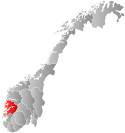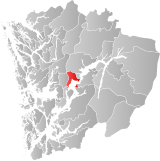Strandebarm Municipality
Strandebarm herad | |
|---|---|
 Hordaland within Norway | |
 Strandebarm within Hordaland | |
| Coordinates: 60°17′N 06°01′E / 60.283°N 6.017°E | |
| Country | Norway |
| County | Hordaland |
| District | Hardanger |
| Established | 1 Jan 1838 |
| • Created as | Formannskapsdistrikt |
| Disestablished | 1 Jan 1965 |
| • Succeeded by | Kvam and Jondal municipalities |
| Administrative centre | Bru |
| Area (upon dissolution) | |
• Total | 112 km2 (43 sq mi) |
| Population (1964) | |
• Total | 1,628 |
| • Density | 15/km2 (38/sq mi) |
| Demonyms | Strandberming Strandeberming[1] |
| Time zone | UTC+01:00 (CET) |
| • Summer (DST) | UTC+02:00 (CEST) |
| ISO 3166 code | NO-1226[2] |
Strandebarm is a former municipality in the old Hordaland county, Norway. The original municipality was large, spanning both sides of the central part of the Hardangerfjorden. It also included the island of Varaldsøy. Over time, the municipality was divided and by the time of its dissolution in 1965, it was 112 square kilometres (43 sq mi). The municipality included land in the present-day municipalities of Ullensvang, Kvam, and Kvinnherad. The administrative center of the municipality was the village of Bru, where Strandebarm Church is located.[3]
One of the larger industries in the municipality was shipbuilding, centered at the village of Omastranda, where the company Fjellstrand A.S. is headquartered.

The Norwegian writer Hans E. Kinck lived in Strandebarm for many years, and is said to have used the village as setting and inspiration for his novel Den nye kapellanen ("The New Vicar").
- ^ "Navn på steder og personer: Innbyggjarnamn" (in Norwegian). Språkrådet.
- ^ Bolstad, Erik; Thorsnæs, Geir, eds. (26 January 2023). "Kommunenummer". Store norske leksikon (in Norwegian). Kunnskapsforlaget.
- ^ Store norske leksikon. "Strandebarm" (in Norwegian). Retrieved 21 June 2014.